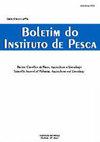Oropharyngeal morphological aspects of Arapaima gigas (Schinz, 1822)
IF 0.6
4区 农林科学
Q4 FISHERIES
引用次数: 0
Abstract
The study of the functional anatomy of the digestive system of fish, in particular the oropharyngeal cavity, is of great importance because it allows inferences about the feeding habit, mechanisms of capture, selection, and processing of food carried out by different species. Thus, the aim of this study was to describe the anatomical adaptations of the oropharyngeal cavity of the pirarucu (Arapaima gigas Schinz, 1822) using scanning electron microscopy (SEM) techniques. The oropharyngeal cavity of six specimens of pirarucu was collected in juvenile phase, from Aquaculture Research Center at the Universidade Federal de Rondônia (UNIR), created for commercial purposes. The anatomical pieces were fixed in 10% buffered formalin and processed for SEM analysis. Anatomically, the oropharyngeal cavity of the pirarucu is composed of five pairs of branchial arches, apical portion of the tongue, floor of the tongue, lower pharyngeal area, and upper pharyngeal plate. In SEM, we observed that the mucosa of the apex of the tongue and the upper pharyngeal roof have a smooth texture and are covered by squamous cells with numerous small openings scattered over the surface. The portions of the floor of the tongue and the lower pharyngeal area, on the other hand, have adaptations in the form of a projectile and numerous sensory papillae, giving a rough texture to the region. Thus, the oropharyngeal cavity of pirarucu is adapted for the capture, apprehension, and swallowing of its prey, with signs of carnivory.巨骨舌鱼的口咽形态学特征(Schinz, 1822)
研究鱼类消化系统的功能解剖,特别是口咽腔,是非常重要的,因为它可以推断不同物种的摄食习惯、捕获机制、选择和食物加工。因此,本研究的目的是利用扫描电子显微镜(SEM)技术描述食人鱼(Arapaima gigas Schinz, 1822)口咽腔的解剖适应性。在幼年时期从Rondônia联邦大学水产养殖研究中心(UNIR)收集了6只皮拉鲁库鱼的口咽腔,该中心是为商业目的而创建的。将解剖片固定在10%的缓冲福尔马林中,并进行扫描电镜分析。解剖上,口咽腔由五对鳃弓、舌尖部、舌底、下咽区和上咽板组成。在扫描电镜中,我们观察到舌尖和咽上顶的粘膜质地光滑,被鳞状细胞覆盖,表面散布着许多小开口。另一方面,舌底部分和下咽区域,以弹射体和许多感觉乳头的形式适应,使该区域具有粗糙的质地。因此,食人鱼的口咽腔适合捕捉、逮捕和吞咽猎物,具有食肉性的迹象。
本文章由计算机程序翻译,如有差异,请以英文原文为准。
求助全文
约1分钟内获得全文
求助全文
来源期刊

Boletim do Instituto de Pesca
FISHERIES-ZOOLOGY
CiteScore
0.80
自引率
0.00%
发文量
24
审稿时长
>12 weeks
期刊介绍:
To publish original articles of research and short communications in the following áreas: Fisheries, Aquaculture, Zootechnology, Limnology, Oceanography, Biology and Pathology of aquatic organisms. The publication depends on the approval of the Editorial Board, based on the peer review.
 求助内容:
求助内容: 应助结果提醒方式:
应助结果提醒方式:


